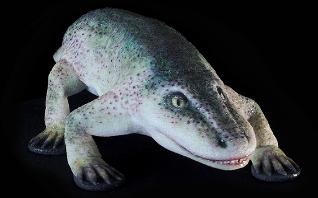Eryops megacephalusis an extinct amphibious predator from the late Carboniferous period (~295 Mya) It was one of the largest land animals of its time, growing up to 3 meters long and weighing around 200 kilograms and possibly the apex predator of the period.

Eryops had a large, broad, and flat skull with a wide mouth and many curved teeth. Its teeth were made of enamel with a folded pattern, which led to it being early classified as a "labyrinthodont" ("maze toothed"). Eryops also had a thick hide covered in hardened tubercles, and large, strong limbs. Eryops would have been a formidable predator.

Discovered in the mid19th century in the Texas Red Beds, (Cope, 1878) Eryops was quickly recognized as a large amphibious predator of the early Permian period. Subsequent fossil discoveries have placed Eryops further back in time to the late Carboniferous (Lucas, et al, 2010).
There would have been many tetrapoda moving between land and water by this time but very few that could have matched Eryops for size and power. It's pelvic and pectoral girdles were massively proportioned. It also had a huge head and wide mouth filled with long enamel teeth. Though squat in appearance Eryops would have been extremely powerful and was probably an apex predator of the Late Carboniferous period.
Eryops had a thick hide covered in hardened, oval tubercles (Romer, 1941) that would have provided good protection against other predators. Even so, as an amphibian with porous skin, it would have had to live in or near water. Unlike reptiles, amphibians are not amniotes so they have to lay their unprotected eggs in water. Although powerful in build Eryops would have been cumbersome on land so would also have been more agile with the assisted buoyancy of being partly submerged. The morphology of Eryops suggests a lifestyle of wallowing and hunting along water margins - in much the same way as the modern hippopotamus - intermittently venturing out onto land in search of additional prey.
In addition to the hard enamel teeth around the margin of the wide mouth, Eryops also had backward facing fangs on its upper palate. These would have been used to grip onto prey as Eryops lunged forward and lifted its head backwards - the same method used by modern crocodiles.

There may have been a time during the late Carboniferous period when amphibians like Eryops megacephalus were the apex land predators.







